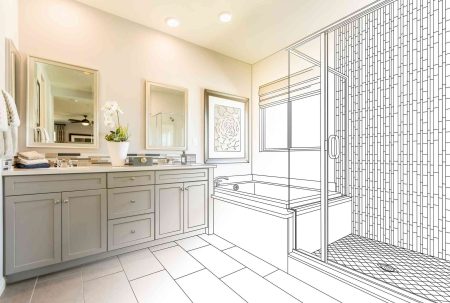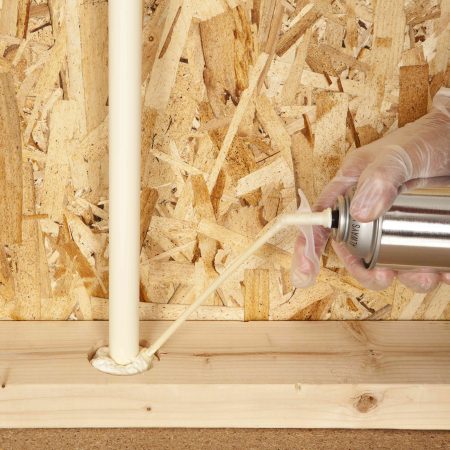Remodel and renovation are often used interchangeably to refer to home upgrades. However, a remodel is not the same type of project as a renovation job. Here’s what to know about the difference between a remodel vs renovation.
What Is a Remodel vs. Renovation?
A remodel project involves adding or constructing something new, like tearing out and replacing the existing bathroom tiles, shower, tub, toilet, and vanity. A renovation project is much more focused on repairing or restoring the existing state of the space, such as painting a room, replacing the wallpaper, or updating the faucet on an existing bathroom vanity.
Home Remodel Projects
Remodel projects will usually have a larger scope than renovation projects. This type of project starts by preparing the current area for the update, which often involves demolishing the existing space and removing any old items, appliances, or other debris. Remodels include:
- Enlarging a closet or room
- Tearing out a wall
- Building an ensuite
- Constructing a home addition
- Demolishing and rebuilding a kitchen or bathroom from the studs
- Building a new deck
- Putting in a new fence
- Finishing an attic or basement
- Adding an additional kitchen or bathroom
Home Renovation Projects
Generally, a home renovation project will be more affordable and it will take less time to complete because you are working with the existing layout, appliances, and other furnishings, instead of simply tearing everything out and starting from scratch. Renovations include:
- Replacing cabinet hardware
- Painting a room
- Installing new light fixtures
- Installing a programmable or smart thermostat
- Updating a kitchen or bathroom faucet
- Replacing old wallpaper
- Sanding and staining an existing deck or fence
- Removing ceiling textures
- Replacing door handles or locks
Pros and Cons of Remodels
Remodeling is ideal for improving the functionality and layout of the home, but it will typically cost more and take longer than a renovation. Remodeling projects will often require a building permit, which adds to the cost of the job. However, remodeling can help to address underlying structural and systems issues that would otherwise remain hidden.
-
Improve functionality
-
Change layout
-
Address underlying problems
-
Extend the home’s lifespan
-
High cost
-
Long timeline
-
Permitting required
-
Not DIY-friendly
Pros and Cons of Renovations
Renovating a home is both affordable and DIY-friendly. A renovation project won’t correct poor home design or address any underlying issues. However, most renovation projects will have a better ROI (return on investment) than remodeling projects, simply because a lot of the expense involved with a remodel goes unseen, like structural changes that are hidden behind new drywall.
-
Affordable
-
Reasonable timeline
-
Good ROI
-
DIY-friendly
-
Does not fix underlying issues
-
Often a short-term solution
-
Cannot fix poor home design
-
Limited upgrade options
Remodel vs. Renovation: Cost
There is a significant difference in price between a remodel project and a renovation project. Extensive home remodel jobs will cost about $47,000 on average, while a renovation projects, like painting, updating flooring, or investing in professional landscaping will cost about $15,000. Renovations jobs will almost always cost less than a remodel project, so if funds are tight, it’s best to settle for a renovation or wait until you have the budget for a full remodel.
Remodel vs. Renovation: Design
In some homes, the original layout is convoluted at best, making it more difficult than necessary to move around or organize the home. When this occurs, a remodel is the right choice. The contractor will be able to demolish the existing space, move walls, expand rooms or closets, or make any other changes to the floor plan and design of the home.
Renovation projects focus more on the aesthetic appearance of the home, rather than the functionality, so a remodel is the best option if you are looking to change the home design. Just keep in mind, some historic homes may not be able to be remodeled, leaving renovation as the only option to update the home.
Remodel vs. Renovation: DIY
In most cases, you will need to hire contractors and potentially even a structural engineer if you are starting a large-scale remodel project. This type of work falls outside of the scope of expertise that most people have managed to build. However, if you only want to renovate the space, then there is a good chance that you will be able to tackle the work as a DIY job.
Projects like painting, staining, or even replacing plumbing fixtures can usually be completed by an experienced DIYer without needing to hire professional contractors. If you are looking for a DIY job that can be completed in a relatively short period of time, then a renovation is more feasible than a remodel project.
Remodel vs. Renovation: ROI
The return on investment (ROI) is a measure of the amount of money you can expect get back when you sell the home. This is a key measurement to consider when deciding on the best upgrade for the home if you are thinking about selling in the near future. If you are not selling or planning to sell, then the ROI is relatively meaningless, since you will not get back any money regardless of the type of upgrade.
While a remodel can address many underlying issues and even make beneficial changes to the layout, many of the expenses go unseen, so they have limited impact on the cost of the home. Renovation projects focus on the aesthetic appearance of the home and tend to cost less, which leads to a higher ROI on average.
Remodel vs Renovation: Permitting
Generally, aesthetic renovation jobs will not require a building permit, since you are not actually changes the structural design or installing any new additions to the home. However, if you are remodeling the home, then there is a high chance that you will need to get a building permit from the local permit office before you can proceed.
Remodel vs. Renovation: Timeline
Remodeling the home will almost always take longer than renovating the home, because there is simply more work involved. A remodel may have a shorter timeline than a renovation project if the remodel is being completed by professional contractors and the renovation project is being handled by a DIYer. This difference in timeline comes down to skill and experience.
However, in most cases, renovations will take as little as one or two days to complete, while a remodel project will generally take several days to several months to wrap up, depending on the extend of the remodel.
-
What is the difference between redesign and remodel?
Redesigning a space generally involves painting, updating flooring, and investing in new furniture, appliances, or other devices to improve the aesthetic appearance and functionality of the existing area.
A remodel project starts by stripping down the space to remove any existing design elements and may even involve changing the structural layout of the area. The contractors will then rebuild the area according to a new plan.
-
What are the three types of renovations?
Renovation projects can be separated into three main categories. The first is cosmetic or facelift renovations, which are relatively minor, like painting or replacing the wallpaper.
The second type is a functional or pull-and-replace renovation, which involves replacing the existing appliances, furniture, furnishings, or fixtures.
The third type is a structural or full-scale renovation in which the contractor may move entire appliance connections or systems to a different area of the room, like a kitchen sink and all associated plumbing.
-
What comes first in renovations?
The first thing that needs to happen during a renovation project is demolition. The contractors will need to remove any old items or materials that will be replaced during the project, such as pulling out old floors, stripping old wallpaper, or removing old light fixtures.
Read the full article here














